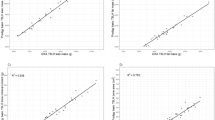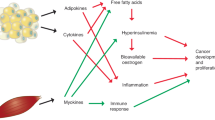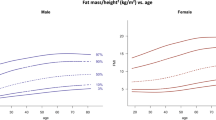Abstract
Background/Objective:
In 1975, a Reference Man for the estimation of radiation doses without adverse health effects was created. However, during the past few decades, considerable changes in body weight and body composition were observed, as a result of which, new in vivo technologies of body composition analysis are now available. Thus, the Reference Man might be outdated as adequate standard to assess medication and radiation doses. The objective of this study was to compare body composition of an adult population with 1975 Reference Man data, thereby questioning its value as a suitable reference.
Methods:
Body composition was assessed in 208 healthy, Caucasian subjects (105 males, 103 females) aged 18–78 years with a body mass index range of 16.8–35.0 kg/m2. Fat mass (FM) and muscle mass (MM) were assessed by dual-energy X-ray absorptiometry, organ masses (OMs) were measured by magnetic resonance imaging.
Results:
There was a considerable variance in body weight and body composition. When compared with Reference Man, great differences in body composition were found. Men and women of the study population were heavier, taller and had more FM, MM and higher masses of brain, heart and spleen. These differences did not depend on age. Relationships between body weight and body composition were investigated by general linear regression models, whereby deviations in FM, MM and heart mass disappeared, whereas differences in brain and spleen mass persisted.
Conclusions:
Our data indicate the need of a modern Reference Man and thus a recalculation of medical radiation doses and medication.
This is a preview of subscription content, access via your institution
Access options
Subscribe to this journal
Receive 12 print issues and online access
$259.00 per year
only $21.58 per issue
Buy this article
- Purchase on Springer Link
- Instant access to full article PDF
Prices may be subject to local taxes which are calculated during checkout


Similar content being viewed by others
References
Aloia JF, Vaswani A, Mikhail M, Flaster ER (1999). Body composition by dual-energy X-ray absorptiometry in black compared with white women. Osteoporos Int 10, 114–119.
Bosy-Westphal A, Reinecke U, Schlorke T, Illner K, Kutzner D, Heller M et al. (2004). Effect of organ and tissue masses on resting energy expenditure in underweight, normal weight and obese adults. Int J Obes Relat Metab Disord 28, 72–79.
Brownbill RA, Ilich JZ (2005). Measuring body composition in overweight individuals by dual energy x-ray absorptiometry. BMC Med Imaging 5, 1.
Duck FA (1990). Physical properties of tissue. Academic Press: New York.
Gallagher D, Albu J, He Q, Heshka S, Boxt L, Krasnow N et al. (2006). Small organs with a high metabolic rate explain lower resting energy expenditure in African American than in white adults. Am J Clin Nutr 83, 1062–1067.
Gallagher D, Belmonte D, Deurenberg P, Wang Z, Krasnow N, Pi-Sunyer FX et al. (1998). Organ-tissue mass measurement allows modeling of REE and metabolically active tissue mass. Am J Physiol 275, E249–E258.
Gasperino J (1996). Ethnic differences in body composition and their relation to health and disease in women. Ethn Health 1, 337–347.
Gately PJ, Radley D, Cooke CB, Carroll S, Oldroyd B, Truscott JG et al. (2003). Comparison of body composition methods in overweight and obese children. J Appl Physiol 95, 2039–2046.
Heymsfield SB, Gallagher D, Mayer L, Beetsch J, Pietrobelli A (2007). Scaling of human body composition to stature: new insights into body mass index. Am J Clin Nutr 86, 82–91.
Kim J, Wang Z, Heymsfield SB, Baumgartner RN, Gallagher D (2002). Total-body skeletal muscle mass: estimation by a new dual-energy X-ray absorptiometry method. Am J Clin Nutr 76, 378–383.
Lahti-Koski M, Seppanen-Nuijten E, Mannisto S, Harkanen T, Rissanen H, Knekt P et al. (2009). Twenty-year changes in the prevalence of obesity among Finnish adults. Obes Rev 11, 171–176.
Laskey MA, Lyttle KD, Flaxman ME, Barber RW (1992). The influence of tissue depth and composition on the performance of the Lunar dual-energy X-ray absorptiometer whole-body scanning mode. Eur J Clin Nutr 46, 39–45.
Lohman TG, Chen Z (2005). Dual-Energy X-Ray Absorpiometry. In: Heymsfield SB, T.G. L, Wang Z, Going SB (eds). Human Body Composition. Human Kinetics: Champaign.
Max Rubner Institute FRCfNaF (2008). Ergebnisbericht Teil 1, Nationale Verzehrsstudie II. Max Rubner Institute FRCfNaF: Karlsruhe.
Ogden CL, Carroll MD, Curtin LR, McDowell MA, Tabak CJ, Flegal KM (2006). Prevalence of overweight and obesity in the United States, 1999-2004. JAMA 295, 1549–1555.
Rahman M, Temple JR, Breitkopf CR, Berenson AB (2009). Racial differences in body fat distribution among reproductive-aged women. Metabolism 58, 1329–1337.
Roche AF (1979). Secular trends in human growth, maturation, and development. Monogr Soc Res Child Dev 44, 1–120.
Roubenoff R, Kehayias JJ, Dawson-Hughes B, Heymsfield SB (1993). Use of dual-energy x-ray absorptiometry in body-composition studies: not yet a ‘gold standard’. Am J Clin Nutr 58, 589–591.
Slosman DO, Casez JP, Pichard C, Rochat T, Fery F, Rizzoli R et al. (1992). Assessment of whole-body composition with dual-energy x-ray absorptiometry. Radiology 185, 593–598.
Snyder WS, Cook MJ, Nasset ES, Karhausen LR, Howells GP, Tipton IH (1975). Report of the Task Group on Reference Man. Pergamon Press: Oxford.
Sparti A, DeLany JP, de la Bretonne JA, Sander GE, Bray GA (1997). Relationship between resting metabolic rate and the composition of the fat-free mass. Metabolism 46, 1225–1230.
Visser M, Fuerst T, Lang T, Salamone L, Harris TB (1999). Validity of fan-beam dual-energy X-ray absorptiometry for measuring fat-free mass and leg muscle mass. Health, aging, and body composition Study–Dual-Energy X-ray Absorptiometry and body composition Working Group. J Appl Physiol 87, 1513–1520.
Wardle J, Boniface D (2008). Changes in the distributions of body mass index and waist circumference in English adults, 1993/1994 to 2002/2003. Int J Obes (Lond) 32, 527–532.
Weinsier RL, Hunter GR, Gower BA, Schutz Y, Darnell BE, Zuckerman PA (2001). Body fat distribution in white and black women: different patterns of intraabdominal and subcutaneous abdominal adipose tissue utilization with weight loss. Am J Clin Nutr 74, 631–636.
World Health Organization (2000). Obesity: preventing and managing the global epidemic. Report of a WHO consultation on Obesity. WHO Technical Report Series: Geneva.
Wu CH, Heshka S, Wang J, Pierson Jr RN, Heymsfield SB, Laferrere B et al. (2007). Truncal fat in relation to total body fat: influences of age, sex, ethnicity and fatness. Int J Obes (Lond) 31, 1384–1391.
Acknowledgements
This study was funded by DFG.
Author information
Authors and Affiliations
Corresponding author
Ethics declarations
Competing interests
The authors declare no conflict of interest.
Rights and permissions
About this article
Cite this article
Later, W., Bosy-Westphal, A., Kossel, E. et al. Is the 1975 Reference Man still a suitable reference?. Eur J Clin Nutr 64, 1035–1042 (2010). https://doi.org/10.1038/ejcn.2010.125
Received:
Revised:
Accepted:
Published:
Issue Date:
DOI: https://doi.org/10.1038/ejcn.2010.125
Keywords
This article is cited by
-
A century of exercise physiology: concepts that ignited the study of human thermoregulation. Part 2: physiological measurements
European Journal of Applied Physiology (2023)
-
Assessment and definition of lean body mass deficiency in the elderly
European Journal of Clinical Nutrition (2014)
-
Impact of body-composition methodology on the composition of weight loss and weight gain
European Journal of Clinical Nutrition (2013)
-
From BMI to functional body composition
European Journal of Clinical Nutrition (2013)
-
Associations between breast adipose tissue, body fat distribution and cardiometabolic risk in women: cross-sectional data and weight-loss intervention
European Journal of Clinical Nutrition (2011)



